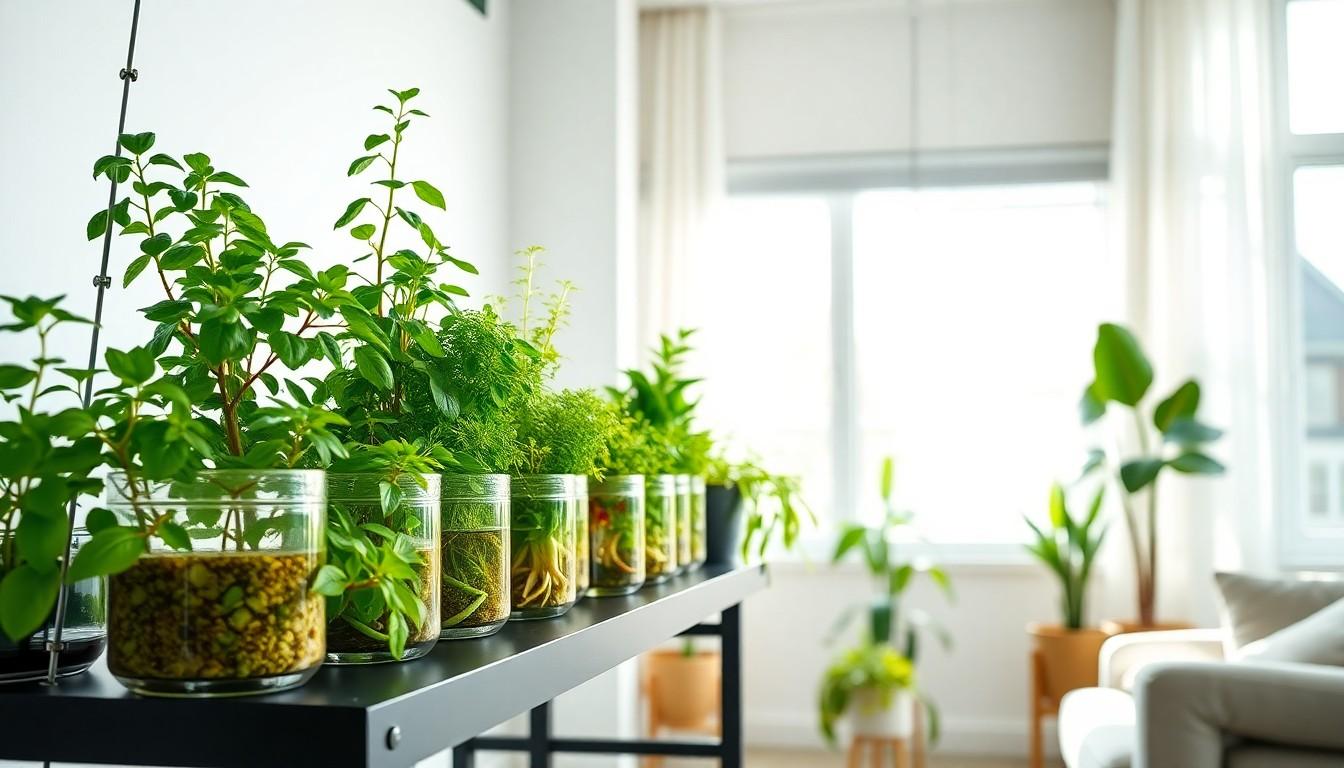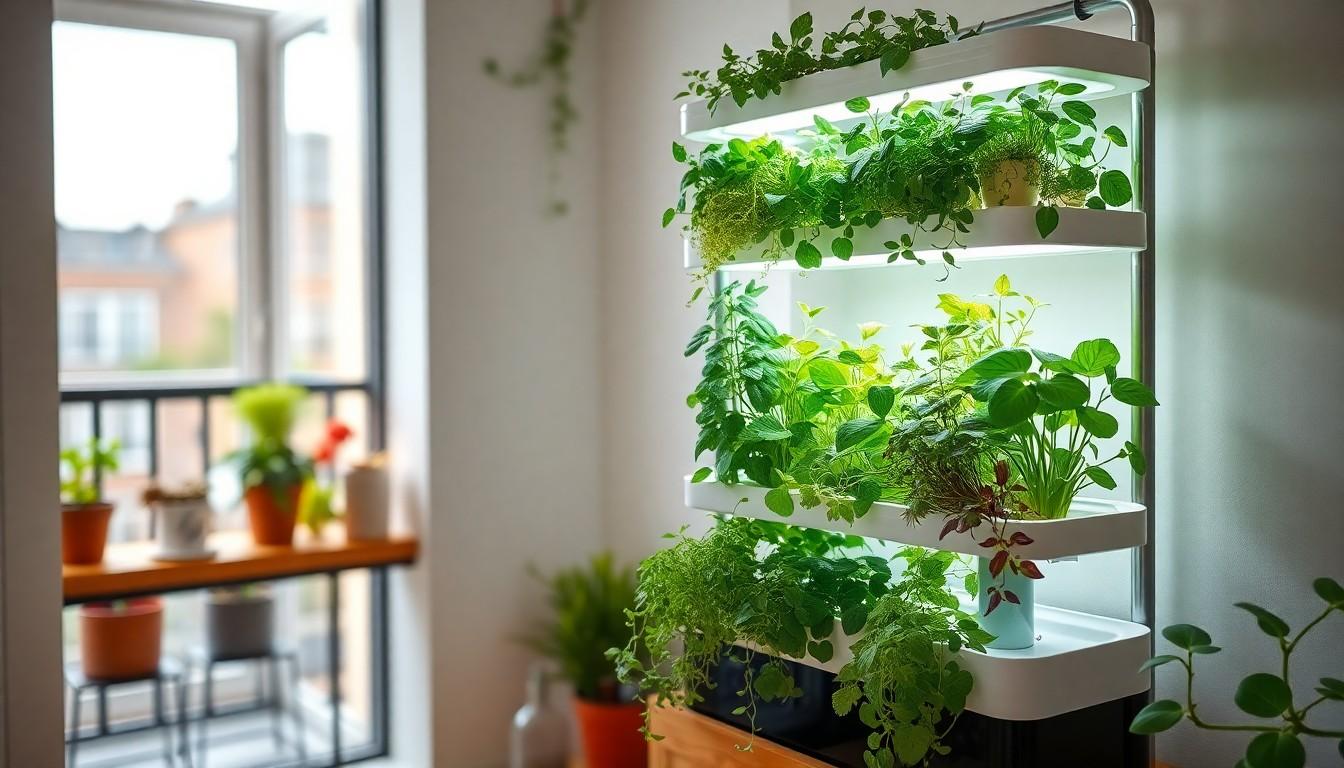Phone:
(701)814-6992
Physical address:
6296 Donnelly Plaza
Ratkeville, Bahamas.

Imagine transforming your home into a lush oasis without the hassle of soil and pesky bugs. Hydroponic house plants make this dream a reality, allowing anyone to become a plant parent without the green thumb. These soil-less wonders thrive in nutrient-rich water, and they’re not just pretty faces—they can purify the air and bring a splash of life to any room.
Hydroponic house plants thrive in water-based systems that replace traditional soil environments. These systems provide a controlled setting, allowing for precise management of nutrients. Many popular house plants, such as basil, mint, and spider plants, adapt well to hydroponic conditions.
Growing hydroponic house plants offers multiple advantages over soil-based methods. First, reduced pests and diseases occur since soil is often a habitat for these issues. Enhanced growth rates result from the constant availability of nutrients and water. For instance, studies show hydroponically grown lettuce matures 30% faster than conventionally grown lettuce.
Hydroponic systems vary in design and complexity. Deep water culture provides oxygen directly to plant roots submerged in nutrient solutions. Nutrient film technique uses a thin layer of water to deliver nutrients, which works well for smaller plants. Wick systems function with a passive approach, drawing nutrient solutions up to the roots through wicks.
Choosing the right hydroponic setup depends on available space and plant preferences. Smaller systems work great for compact areas, while larger setups support a broader variety of plants. Hydroponic growth also contributes positively to indoor air quality, filtering toxins while increasing humidity.
Nurturing hydroponic house plants becomes less labor-intensive compared to traditional gardening. Regular monitoring of pH levels and nutrient concentrations ensures optimal growth conditions. With minimal attention required once established, these plants offer significant rewards for both aesthetics and indoor health.

Hydroponic growing presents numerous advantages for home gardeners. These benefits enhance both the living environment and the efficiency of plant cultivation.
Space efficiency marks a key advantage of hydroponic systems. Vertical setups allow individuals to maximize limited areas, such as apartments and small homes. These systems require less footprint compared to traditional gardening. Small hydroponic setups, including window farms, accommodate popular house plants like herbs and leafy greens. Compact designs enable users to grow multiple varieties without sacrificing space. Choosing hydroponics means opting for a versatile solution that fits any indoor environment.
Water conservation plays a significant role in hydroponic growing. Unlike conventional gardening, these systems use significantly less water—up to 90% less—in some cases. Closed-loop systems recirculate water, minimizing wastage and promoting efficient nutrient delivery. Efficient water use helps gardeners maintain optimal moisture levels without excess runoff. Reducing water consumption proves vital for urban settings where resources can be scarce. Hydroponics ultimately supports sustainable practices, making it an environmentally friendly choice for nurturing plants indoors.
Hydroponic house plants come in various types, catering to different levels of expertise and preferences. These selections highlight easy-to-grow options and unique choices for enthusiasts.
Basil stands out as a beginner-friendly plant, thriving in nutrient-rich water. Mint also performs well in hydroponic systems, offering fresh leaves for culinary uses. Lettuce, known for rapid growth, can mature significantly faster in hydroponic setups than in soil. Spider plants adapt easily, making them a great choice for new growers. Additionally, pothos showcases resilience, tolerating lower light levels effectively.
Aquaponics feeds tropical fish and plants simultaneously, enabling synergistic growth. Oncidium orchids add beauty and a touch of elegance, appealing to lovers of unique flora. Bok choy thrives in hydroponic conditions while providing nutritious greens for dishes. Finally, stevia plants offer natural sweetness, presenting a unique alternative for home gardening. These selections cater to those seeking distinctive varieties beyond traditional house plants.
Hydroponic systems facilitate soil-less plant growth through nutrient-rich water. Various setups cater to different needs, ensuring successful cultivation for diverse house plants.
Various hydroponic systems exist, each tailored for specific growing conditions. Deep Water Culture (DWC) submerges plant roots in oxygenated nutrient solutions, promoting rapid growth. Nutrient Film Technique (NFT) continuously films nutrients over roots, enabling efficient nutrient absorption. Wick systems use capillary action to draw nutrients to roots, suitable for smaller plants. Aeroponics suspends plants in air while nutrient mist nourishes them, enhancing oxygen exposure. Choose a system based on available space and desired plant types.
Essential equipment forms a foundation for successful hydroponic gardening. Grow lights provide adequate lighting for plants, especially in low-light environments. Nutrient solutions deliver necessary minerals, tailored to plant types and growth stages. pH meters ensure balanced acidity, promoting optimal nutrient absorption. Water pumps facilitate nutrient circulation, preventing stagnation in the system. Additionally, net pots support the plants and promote root growth. Consider investing in timers and reservoirs to automate processes for efficient growth management.
Maintaining hydroponic plants involves careful management of nutrient solutions and environmental conditions. Regular attention ensures healthy growth and an attractive appearance.
Nutrient solutions play a critical role in hydroponic systems. Specific nutrient ratios must be adhered to for optimal plant health. Common ingredients include nitrogen, phosphorus, potassium, calcium, and magnesium. Regularly monitoring electrical conductivity (EC) levels helps determine nutrient concentration, ensuring plants receive adequate nourishment. Adjustments may become necessary based on plant growth stages, with young plants needing lower concentrations than mature ones. Checking pH levels between 5.5 and 6.5 promotes nutrient uptake. Furthermore, replacing solutions every two weeks prevents nutrient imbalances and stagnation, supporting vigorous plant growth.
Lighting significantly impacts the growth of hydroponic plants. Full-spectrum grow lights mimic sunlight, catering to the varying light needs of different plant species. Placing grow lights 12 to 24 inches above plants optimizes exposure without causing heat stress. Additionally, maintaining a temperature range of 65°F to 75°F supports healthy growth. Humidity levels between 40% and 60% promote optimal transpiration and nutrient absorption. Air circulation also plays a role, with fans preventing mold growth and improving air exchange. Keeping these environmental factors in check creates an ideal habitat for hydroponic plants.
Hydroponic house plants offer an innovative way to enhance indoor spaces while promoting sustainable gardening practices. Their ability to thrive without soil makes them ideal for urban dwellers and those with limited gardening experience. With various systems available, individuals can select setups that fit their space and plant preferences.
The benefits extend beyond aesthetics. Improved air quality and efficient water use make hydroponics an environmentally friendly choice. As more people embrace this method, the appeal of growing vibrant plants indoors continues to grow. Whether starting with easy-to-care-for varieties or exploring unique options, hydroponic gardening provides a rewarding experience that cultivates both beauty and sustainability.